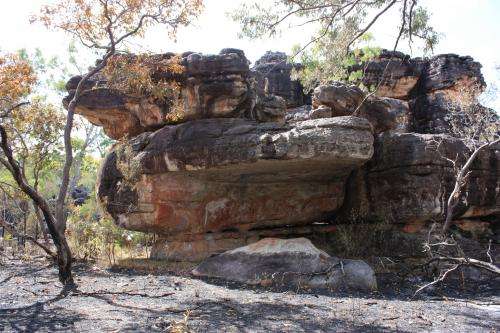Australian rock art is threatened by a lack of conservation (w/ Video)

Australian rock art is under threat from both natural and cultural forces impacting on sites. But what saddens me the most is that there is so much government lethargy in Australia when it comes to documenting and protecting Australia's rock art.
The Weekend Australian reported that 1,700 engraved boulders were removed to make way for the North West Shelf gas plant on Western Australia's Burrup Peninsula in the early 1980s were relocated to a ridge.
They sat in a fenced compound for 30 years alongside others damaged due to neglect. Although the original landscape context of the art was destroyed at least they are now out of what was called the "the graveyard".
But now, impending changes to the Aboriginal Heritage Act by the Western Australian government means Aboriginal heritage will be worse off than ever before. This is because one person, possibly without relevant expertise, will be given the power to say yes or no to site destruction for development rather than a committee of experts.
Our article last week on the discovery of Indonesian rock paintings and hand stencils almost 40,000 years old generated much interest. Many comments focused on the need to better conserve and look after our shared rock art heritage.
The importance of rock art
Rock art sites are museums and art galleries embedded in natural landscapes, with ongoing cultural connection for contemporary Indigenous peoples. Despite this, and unlike built museums and galleries, the ability to continue to care for many of these important places is limited.
Some well known sites include Djulirri, in Arnhem Land, Eagle's Reach in Wollemi National Park in New South Wales and the famous Laura-Quinkan sites of far north Queensland. But none of them have high security, protection from the elements or lots of financial support like built art galleries.
Australian rock art is extremely significant for Indigenous peoples of Australia, with its preservation important for Indigenous well-being. But it also should be a part of Australian national identity and World Heritage pride.
The earliest Australian rock art has been dated to almost 30,000 years ago and there may be older rock art given the new dates from nearby Indonesia. As many as 100,000 rock art sites lie across Australia and new discoveries are made each year.
But Australia has never had coordinated approaches to rock art documentation, conservation and management so the full extent of rock art is unknown.
Rock art is in peril because of development pressures, graffiti, vandalism, poor tourist management and several natural impacts. Some rock art sites have already been vandalised such as the rock engravings on the Burrup Peninsula, in Western Australia.
Conservation failing

Current conservation methods fail because of a lack of a coordinated approach, lack of cultural context, reactionary methods, lack of training, minimal research and mismanagement.
Part of the problem is that rock art sites are key components of cultural landscapes and Indigenous Australians argue for a cultural landscape approach to their preservation so that development will have minimal impact on sites.
Non-Indigenous Australians prefer a more site-specific approach so that heritage preservation can have minimal impact on development.
Rock art sits in an ambiguous place – is it art, part of the environment, heritage, archaeology or is it something else? This lack of clear classification has allowed rock art to slip through the cracks of government portfolios.
For instance, although it is "art" it is not in generously funded arts portfolios. It usually is considered "heritage" but is always the poor second cousin of the natural and built heritage of Australia.
Australia's National Heritage Strategy has recently been under review by both Labor and Liberal-led federal governments but rock art barely gets a mention in draft documents. Australia has never had a national rock art research or conservation strategy.
Recent and impending changes to legislation to reduce so-called "green tape" and new development plans for northern Australia could impact severely on rock art.
Both the final report from Inquiry into the Development of Northern Australia, released in September, and the Cape York Regional Plan for Northern Queensland, released in August, fail to say much, if anything, about the risks to rock art, let alone how these will be minimised.
Rock art attracts tourists

Tourists are interested in rock art and there are a number of sites open to the public across Australia. And many Indigenous communities would like to develop well-managed rock art tourism ventures.
But we need to study rock art sites already open to tourists to see what is working and what is not, as well as to develop new inexpensive and sustainable rock art experiences.
Unfortunately, rock art conservation research has difficulty attracting Australian funding because many people do not see this as "sexy" research or research at all.
But rock art should never be destroyed or removed to compounds to make way for any new development.
So I am working with a group of Indigenous and non-Indigenous people to develop Australia's first national rock art conservation strategy.
This follows from a 10-day workshop in Kakadu National Park in August during which many Aboriginal participants became visibly emotional talking about threats to their sites. The strategy and an associated implementation plan will be available early next year.
But it can only be undertaken with widespread government and community support, and significant funding.
Provided by The Conversation
This story is published courtesy of The Conversation (under Creative Commons-Attribution/No derivatives).![]()




















